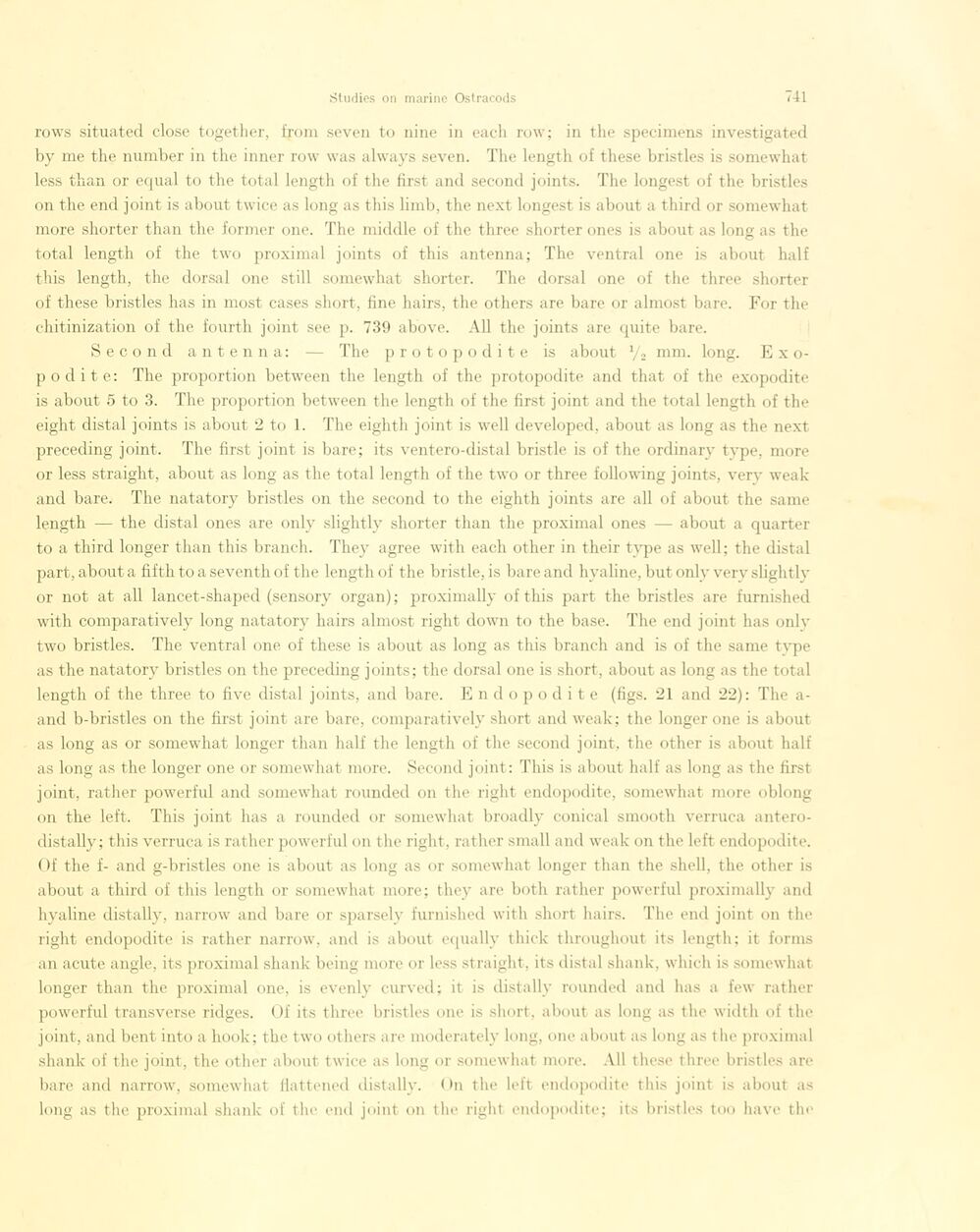
Full resolution (JPEG) - On this page / på denna sida - Sidor ...

<< prev. page << föreg. sida << >> nästa sida >> next page >>
Below is the raw OCR text
from the above scanned image.
Do you see an error? Proofread the page now!
Här nedan syns maskintolkade texten från faksimilbilden ovan.
Ser du något fel? Korrekturläs sidan nu!
This page has never been proofread. / Denna sida har aldrig korrekturlästs.
rows situated close togetlier, from seven to nine in eacli row; in the specimens investigated
by me the number in the inner row was always seven. The length of these bristles is somewhat
less than or equal to the total length of the first and second joints. The longest of the bristles
on the end joint is about twice as long as this limb, the next longest is about a third or somewhat
more shorter than the former one. The middle of the three shorter ones is about as long as the
total length of the two proximal joints of this antenna; The ventral one is about half
this length, the dorsal one still somewhat shorter. The dorsal one of the three shorter
of these bristles has in most cases short, fine hairs, the others are bare or almost bare. For the
chitinization of the fourth joint see p. 739 above. All the joints are quite bare.
Second antenna: — The protopodite is about y2 mm. long. E x
o-p o d i t e : The proportion between the length of the protopodite and that of the exopodite
is about 5 to 3. The proportion between the length of the first joint and the total length of the
eight distal joints is about 2 to 1. The eighth joint is well developed, about as long as the next
preceding joint. The first joint is bare; its ventero-distal bristle is of the ordinary type, more
or less straight, about as long as the total length of the two or three following joints, very weak
and bare. The natatory bristles on the second to the eighth joints are all of about the same
length — the distal ones are only slightly shorter than the proximal ones — about a quarter
to a third longer than this branch. They agree with each other in their type as well; the distal
part, about a fifth to a seventh of the length of the bristle, is bare and hyaline, but onlv verv slightly
or not at all lancet-shaped (sensory organ); proximally of this part the bristles are furmshed
with comparatively long natatory hairs almost right down to the base. The end joint has onlv
two bristles. The ventral one of these is about as long as this branch and is of the same type
as the natatory bristles on the preceding joints; the dorsal one is short, about as long as the total
length of the three to five distal joints, and bare. Endopodite (figs. 21 and 22): The
a-and b-bristles on the first joint are bare, comparatively short and weak; the longer one is about
as long as or somewhat longer than half the length of the second joint, the other is about half
as long as the longer one or somewhat more. Second joint: This is about half as long as the first
joint, rather powerful and somewhat rounded on the right endopodite, somewhat more oblong
on the left. This joint lias a rounded or somewhat broadly conical smooth verruca
antero-distally ; this verruca is rather powerful on the right, rather small and weak on the left endopodite.
Of the f- and g-bristles one is about as long as or somewhat longer than the shell, the other is
about a third of this length or somewhat more; they are both rather powerful proximally and
hyaline distally, narrow and bare or sparsely furnished with short hairs. The end joint on the
right endopodite is rather narrow, and is about equally thick throughout its length; it forms
an acute angle, its proximal shank being more or less straight, its distal shank, which is somewhat
longer than the proximal one, is evenly curved; it is distally rounded and lias a few rather
powerful transverse ridges. Of its three bristles one is short, about as long as the width of the
joint, and bent into a hook; the two others are moderately long, one about as long as the proximal
shank of the joint, the other about twice as long or somewhat more. Ail these three bristles are
bare and narrow, somewhat Hattened distally. On the left endopodite this joint is about as
long as the proximal shank of the end joint on the right endopodite; its bristles too have the
<< prev. page << föreg. sida << >> nästa sida >> next page >>